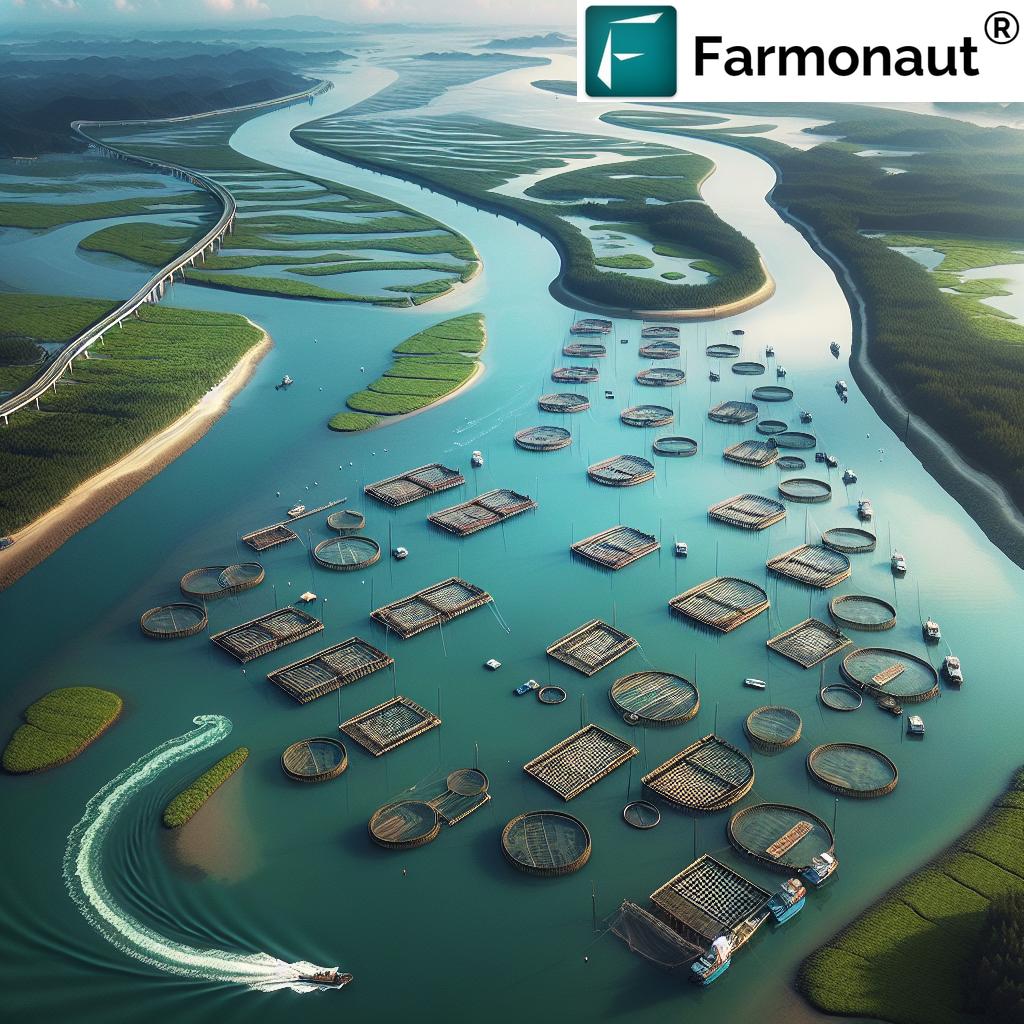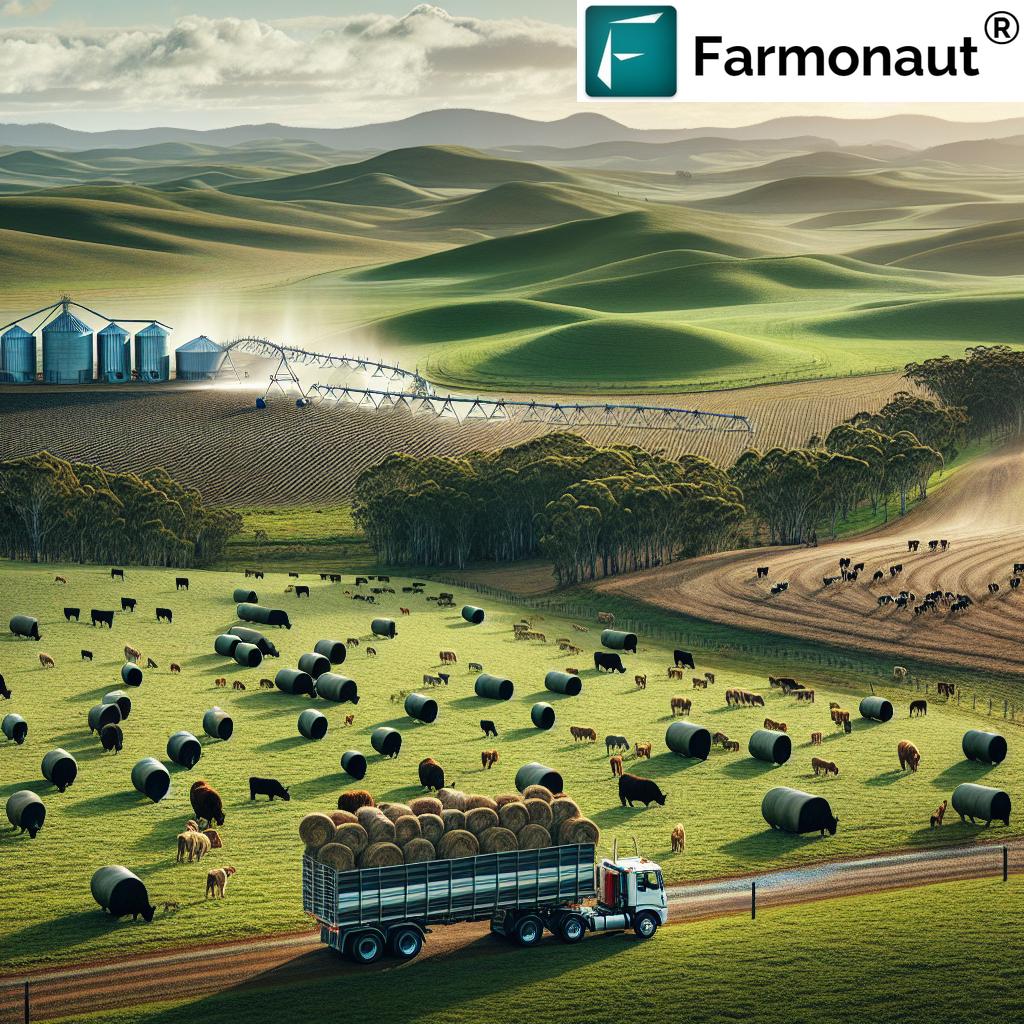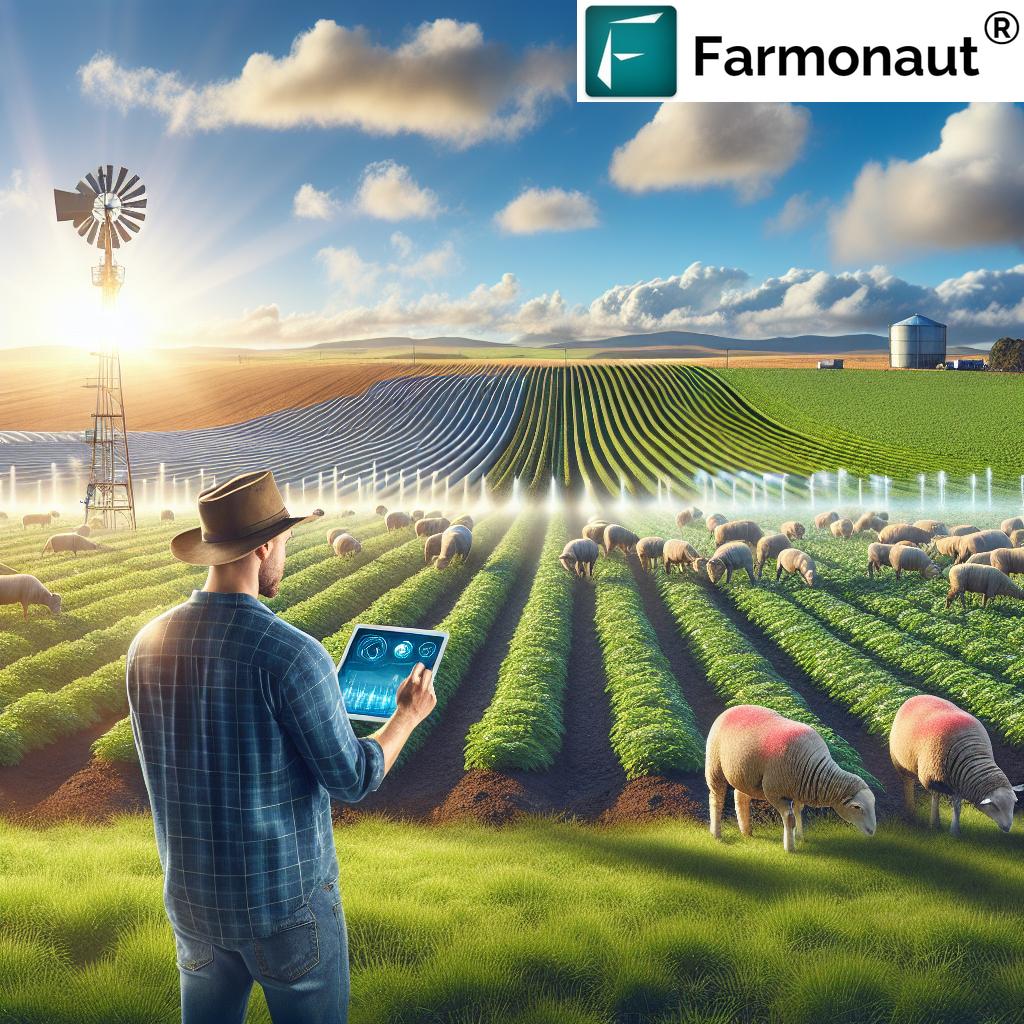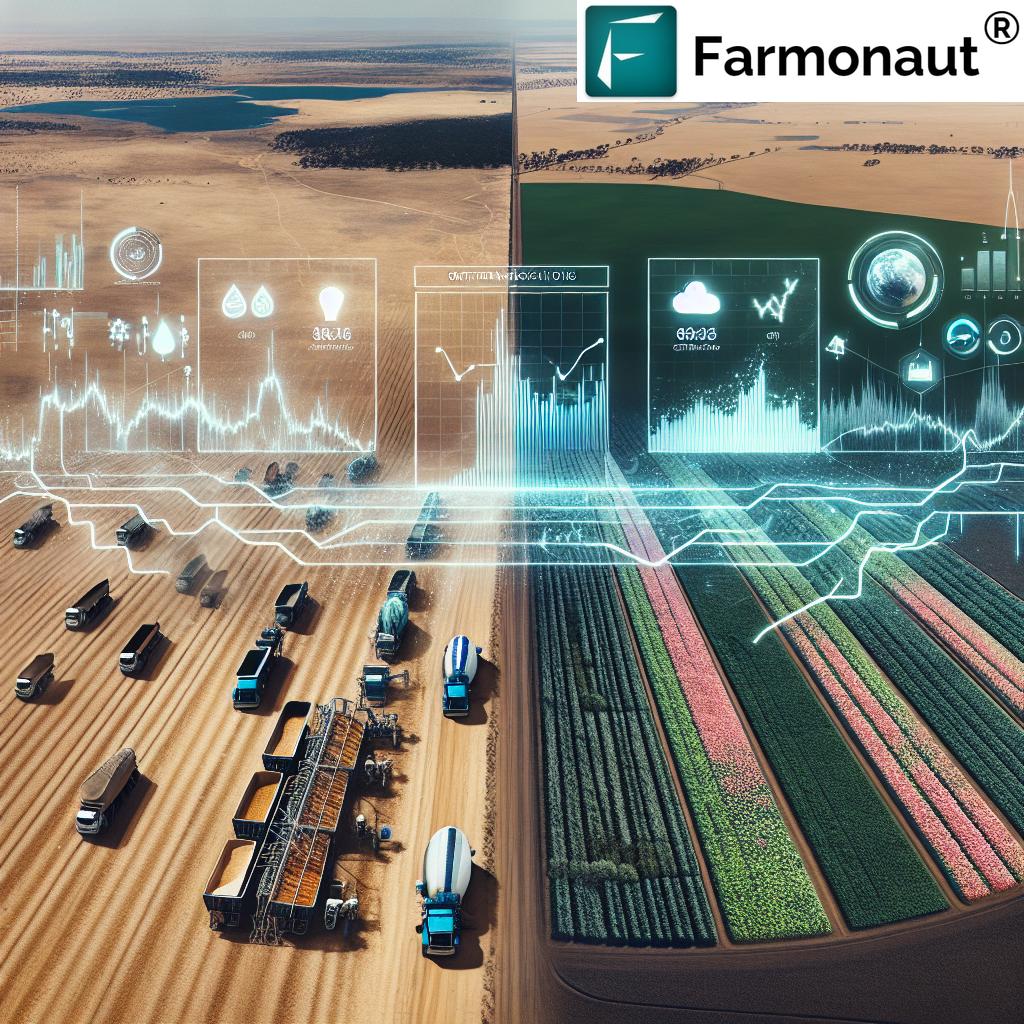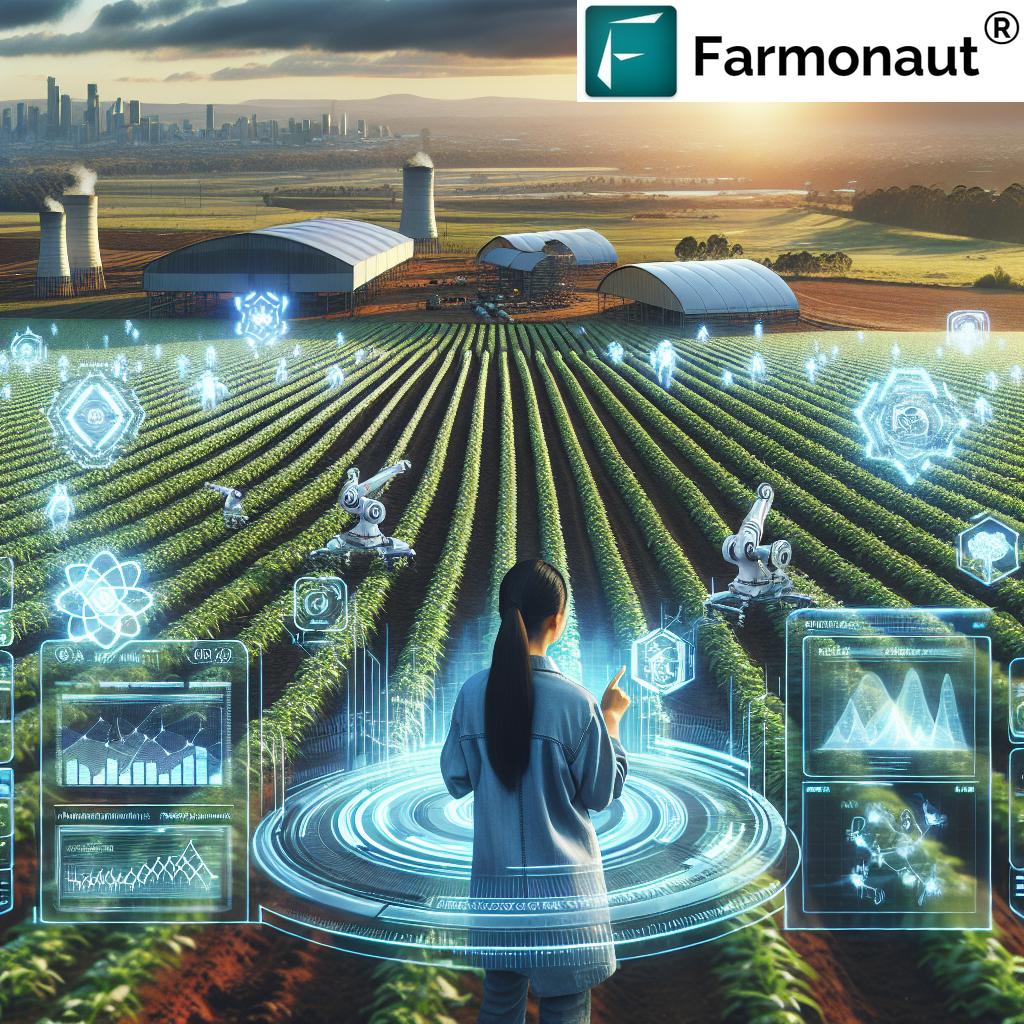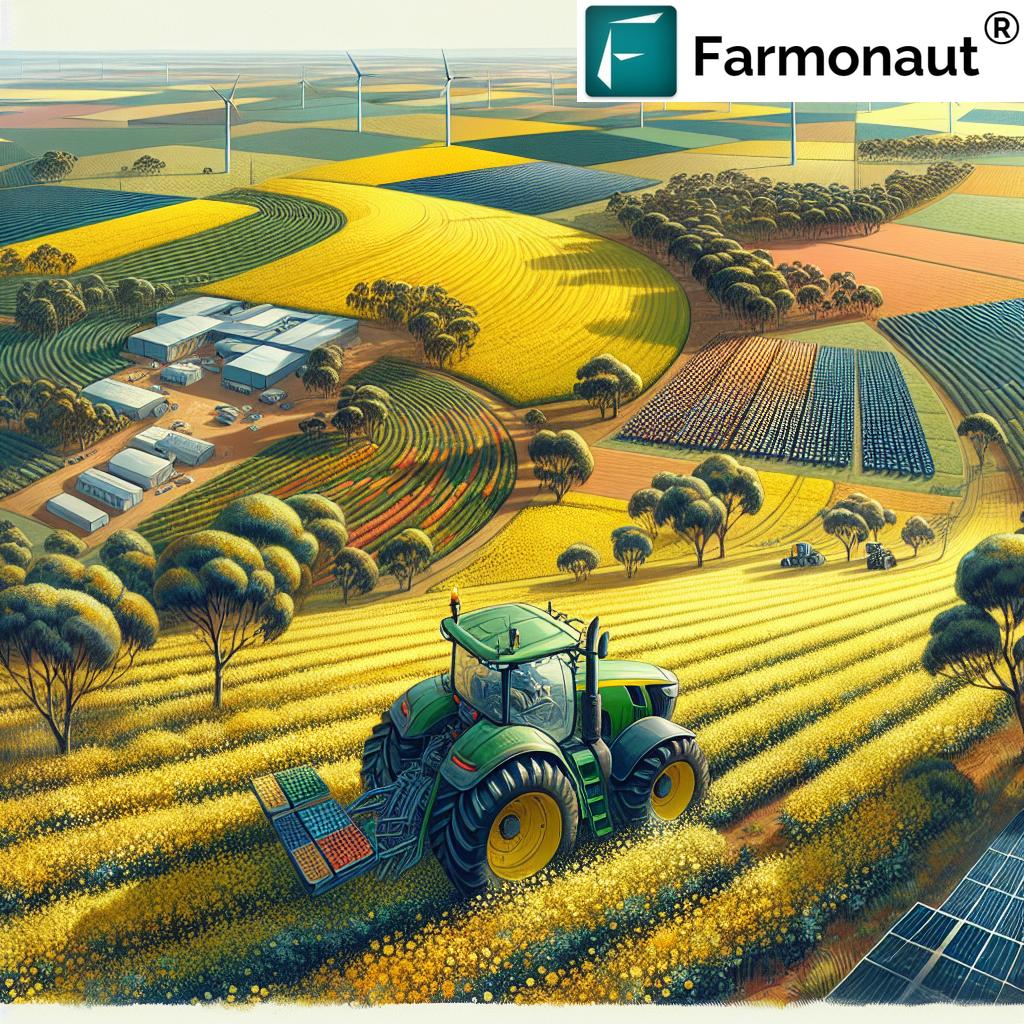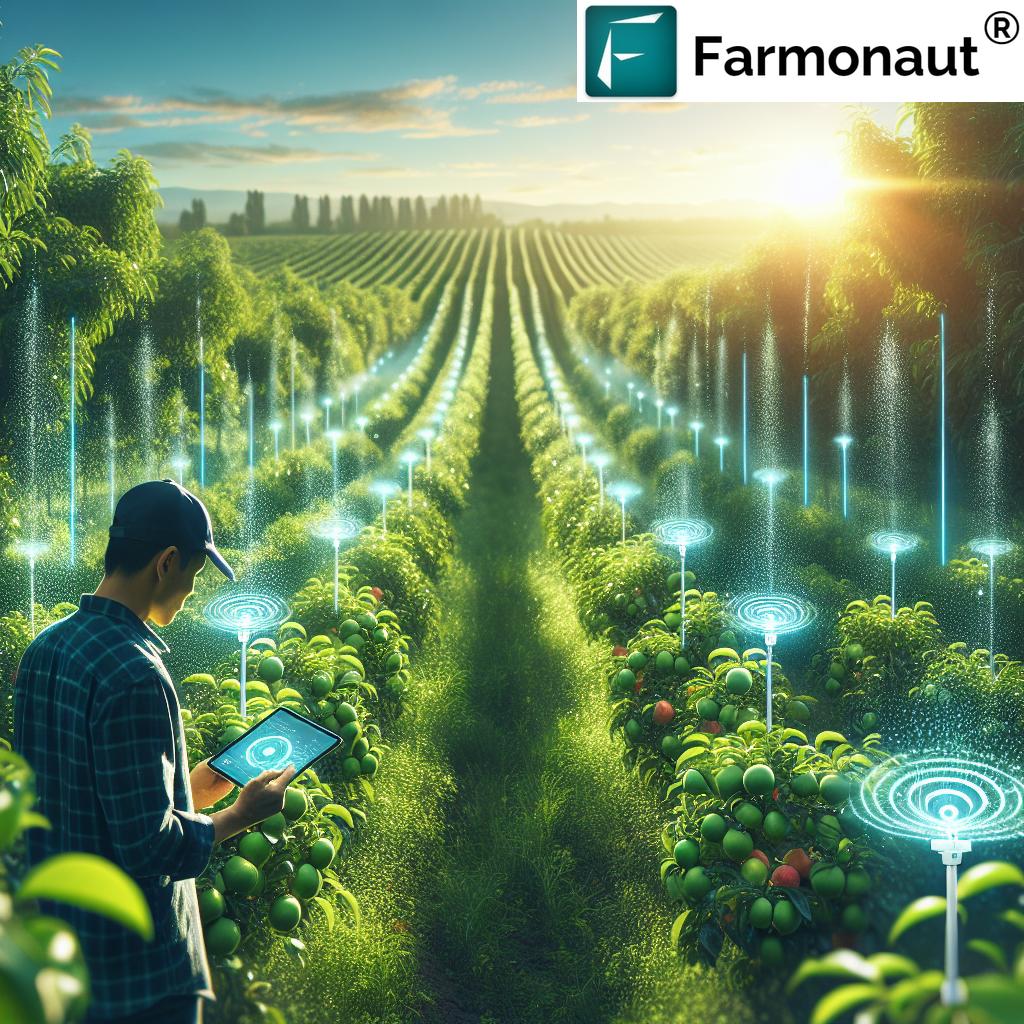From Farm to Fantasy: Queensland’s Merino Wool Revolutionizes Sustainable Costume Design
“Queensland Merino wool reduces costume carbon footprint by up to 50% compared to synthetic materials.”
Welcome to a world where agricultural innovation meets high fashion, where the humble sheep farm transforms into a beacon of sustainable design. In this blog post, we’ll take you on an exciting journey from the rolling hills of Queensland to the glittering stages of costume design, exploring how Merino wool is revolutionizing the fashion industry. Join us as we unravel the fascinating story of how Farmonaut’s cutting-edge agtech solutions are paving the way for a more sustainable and creative future in textile production.
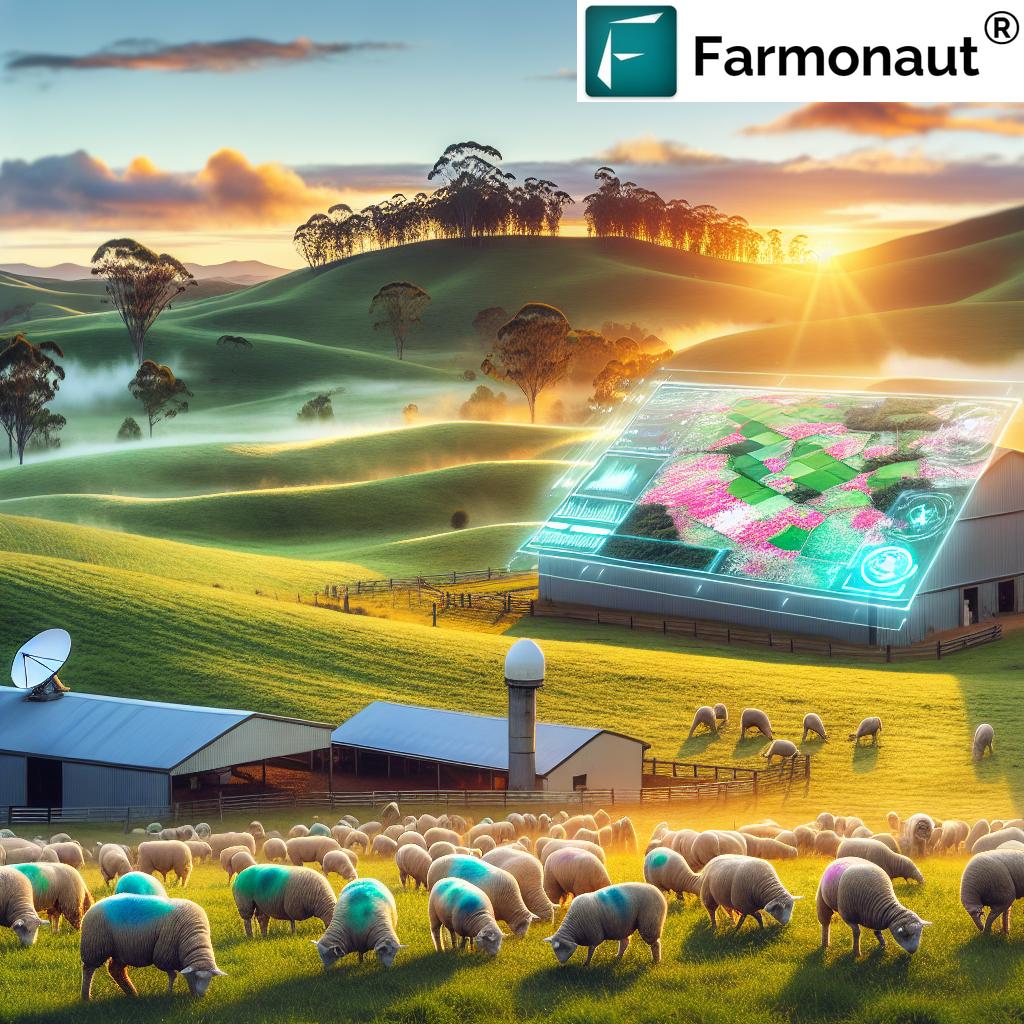
The Rise of Sustainable Agricultural Materials in Fashion
In recent years, we’ve witnessed a significant shift in the fashion industry towards more sustainable and eco-friendly practices. As consumers become increasingly aware of the environmental impact of their clothing choices, designers and brands are turning to innovative solutions to meet this growing demand. One such solution that has captured the imagination of the fashion world is the use of sustainable agricultural materials, with Merino wool from Queensland leading the charge.
But what makes Merino wool so special? Let’s dive into the unique properties that have made this natural fiber a game-changer in the world of sustainable costume design:
- Biodegradability: Unlike synthetic materials, Merino wool naturally decomposes, reducing its long-term environmental impact.
- Durability: Merino wool fibers are incredibly strong, ensuring that garments last longer and reduce the need for frequent replacements.
- Versatility: From lightweight summer garments to warm winter wear, Merino wool adapts to various design needs.
- Natural odor resistance: This property makes it ideal for costume design, where garments may be worn for extended periods.
- Moisture-wicking: Merino wool keeps wearers comfortable by naturally regulating body temperature.
These remarkable qualities have not gone unnoticed by costume designers, who are constantly seeking materials that can withstand the rigors of performance while aligning with sustainable practices.
Farmonaut: Bridging the Gap Between Farm and Fashion
At the heart of this agricultural revolution is Farmonaut, a pioneering agtech company that’s transforming the way we approach farming and textile production. By leveraging advanced satellite imagery and AI-driven insights, Farmonaut is empowering farmers to produce high-quality Merino wool more efficiently than ever before.
Here’s how Farmonaut’s innovative solutions are making a difference:
- Satellite-Based Crop Health Monitoring: Farmers can now track the health of their pastures in real-time, ensuring optimal grazing conditions for Merino sheep.
- AI-Powered Advisory Systems: The Jeevn AI system provides personalized recommendations for flock management and pasture rotation, maximizing wool quality and yield.
- Blockchain-Based Traceability: Fashion brands can now trace the journey of Merino wool from farm to garment, ensuring transparency and authenticity.
- Resource Management Tools: Efficient use of water and other resources leads to a more sustainable wool production process.
By providing farmers with these cutting-edge tools, Farmonaut is not only improving the quality and sustainability of Merino wool production but also ensuring that the fashion industry has access to a steady supply of this premium, eco-friendly material.
From Pasture to Runway: The Journey of Queensland’s Merino Wool
Let’s follow the fascinating journey of Merino wool from the sun-drenched pastures of Queensland to the glittering world of high-end costume design:
- Sustainable Farming: It all begins with the Merino sheep, grazing on lush Queensland pastures managed with Farmonaut’s precision agriculture techniques.
- Ethical Shearing: The wool is carefully harvested using humane practices, ensuring the well-being of the sheep.
- Processing and Spinning: The raw wool is cleaned, combed, and spun into yarn, ready for the next stage of its journey.
- Dyeing and Treatment: Using eco-friendly dyes and treatments, the wool is prepared for its transformation into stunning costumes.
- Design and Creation: Talented costume designers work their magic, turning the sustainable Merino wool into breathtaking garments.
- Stage and Screen: The finished costumes take center stage, dazzling audiences while showcasing the beauty and versatility of Merino wool.
This journey represents a perfect fusion of agricultural innovation and creative artistry, with Farmonaut’s technology playing a crucial role in ensuring the quality and sustainability of the wool at every step.
Experience the future of agriculture with Farmonaut’s web app

The Impact of Sustainable Costume Design
The adoption of Merino wool in costume design is having a profound impact on both the fashion industry and the environment:
- Reduced Carbon Footprint: Merino wool production generates significantly fewer greenhouse gas emissions compared to synthetic materials.
- Water Conservation: Farmonaut’s precision agriculture techniques help farmers use water more efficiently, reducing the overall water footprint of wool production.
- Biodiversity Protection: Sustainable grazing practices promoted by Farmonaut help maintain healthy ecosystems and protect native flora and fauna.
- Economic Benefits: The increased demand for sustainable materials is providing new opportunities for Queensland’s rural communities.
- Inspiration for the Industry: The success of Merino wool in costume design is inspiring other sectors of the fashion industry to embrace sustainable materials.
As we can see, the ripple effects of this sustainable revolution extend far beyond the stage and screen, touching every aspect of the agricultural and fashion ecosystems.
Innovative Applications of Merino Wool in Costume Design
Costume designers are pushing the boundaries of what’s possible with Merino wool, creating stunning and sustainable garments that captivate audiences. Here are some innovative applications we’re seeing:
- 3D-Knitted Costumes: Using advanced knitting technology to create seamless, three-dimensional garments that reduce waste.
- Felted Accessories: Creating intricate headpieces and accessories using wet felting techniques.
- Laser-Cut Designs: Precision cutting of Merino wool fabric to create intricate patterns and textures.
- Blended Fabrics: Combining Merino wool with other sustainable fibers to create unique textures and properties.
- Digital Printing: Using eco-friendly dyes to print complex designs directly onto Merino wool fabric.
These innovative techniques not only showcase the versatility of Merino wool but also demonstrate how sustainable materials can be at the forefront of cutting-edge design.
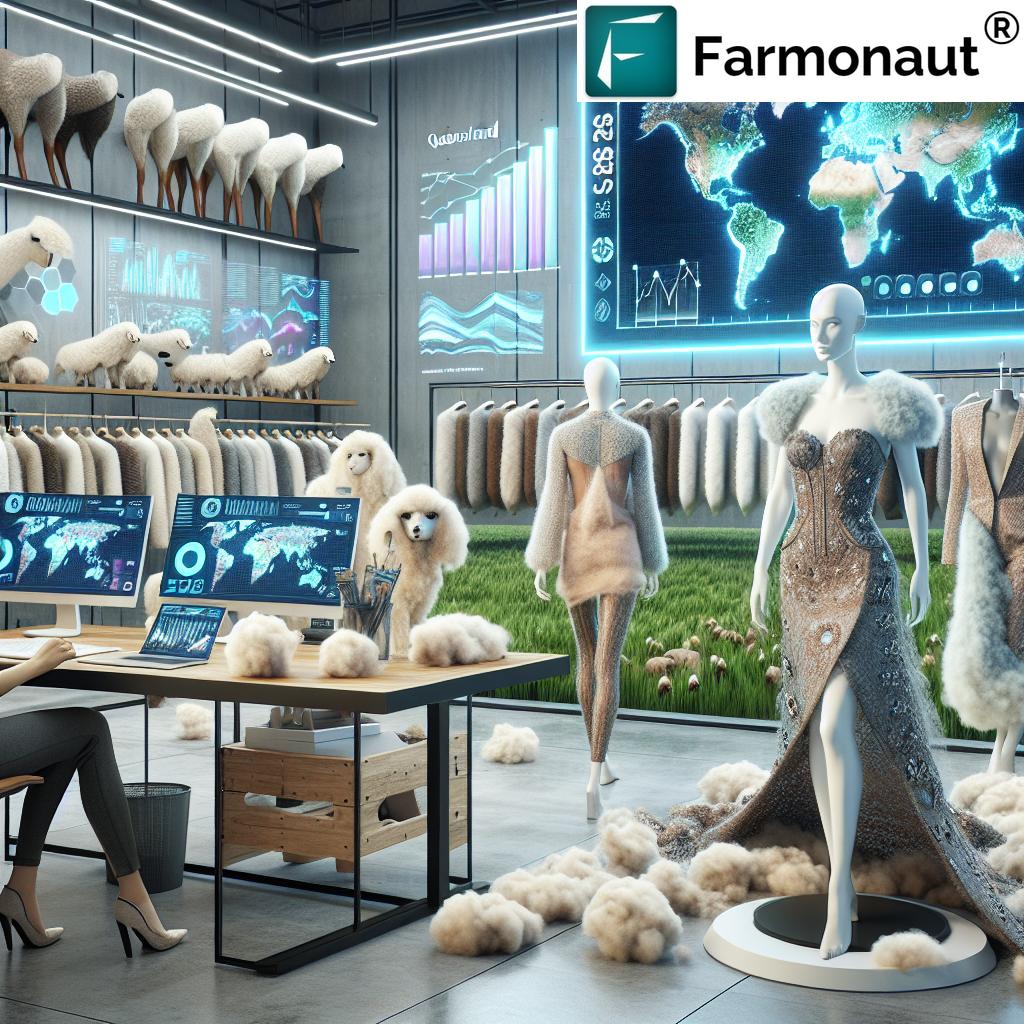
“Farmonaut’s satellite imagery increases wool production efficiency by 30%, supporting sustainable fashion initiatives.”
The Role of Technology in Sustainable Textile Production
Farmonaut’s technological innovations are not limited to the farm. The company’s solutions are making waves throughout the entire textile production chain:
- Supply Chain Transparency: Blockchain-based traceability allows consumers to verify the origin and journey of their Merino wool garments.
- Quality Control: AI-powered image analysis helps identify and sort wool fibers based on quality, ensuring consistency in the final product.
- Resource Optimization: Smart sensors and data analytics help textile manufacturers reduce water and energy usage during processing.
- Precision Dyeing: Advanced color matching algorithms and spectrophotometry enable more accurate and efficient dyeing processes, reducing waste.
By integrating these technologies into the textile production process, we’re not only improving efficiency but also reducing the environmental impact of costume and fashion design.
Explore Farmonaut’s API for advanced agricultural insights
The Future of Sustainable Costume Design
As we look to the future, the potential for sustainable costume design using Merino wool seems boundless. Here are some exciting trends and possibilities we’re anticipating:
- Smart Textiles: Integration of conductive Merino wool fibers to create costumes with embedded technology for interactive performances.
- Bioengineered Dyes: Development of new, environmentally friendly dyes derived from agricultural by-products.
- Circular Fashion: Implementation of closed-loop systems where old Merino wool costumes are recycled into new garments.
- Virtual Prototyping: Use of 3D modeling and virtual reality to design and test costumes, reducing material waste in the sampling process.
- Regenerative Agriculture: Adoption of farming practices that not only sustain but improve soil health and biodiversity, further enhancing the sustainability of Merino wool production.
These advancements promise to make sustainable costume design not just an alternative, but the new standard in the industry.
Comparative Analysis: Merino Wool vs. Traditional Costume Materials
To truly appreciate the impact of Merino wool in sustainable costume design, let’s compare it to traditional materials used in the industry:
| Material Type | Sustainability Score (1-10) | Durability Rating (1-10) | Carbon Footprint (Estimated kg CO2e per kg of material) | Water Usage (Estimated liters per kg of material) | Biodegradability | Versatility in Design (1-10) |
|---|---|---|---|---|---|---|
| Merino Wool | 9 | 8 | 25 | 500 | Yes | 9 |
| Synthetic Fabrics | 3 | 7 | 40 | 60 | No | 8 |
| Cotton | 6 | 6 | 8 | 10000 | Yes | 7 |
| Leather | 4 | 9 | 110 | 17000 | Yes (but slowly) | 6 |
| Silk | 7 | 7 | 35 | 6000 | Yes | 8 |
As we can see from this comparison, Merino wool stands out for its excellent balance of sustainability, durability, and versatility. Its lower carbon footprint and water usage, combined with its biodegradability, make it an ideal choice for eco-conscious costume designers.
Access Farmonaut’s API Developer Docs for seamless integration
Challenges and Solutions in Sustainable Costume Design
While the adoption of Merino wool in costume design offers numerous benefits, it’s not without its challenges. Let’s explore some of these hurdles and the innovative solutions being developed to overcome them:
- Challenge: Cost – Sustainable materials can be more expensive initially.
Solution: Farmonaut’s efficiency-boosting technologies are helping to reduce production costs, making Merino wool more competitive. - Challenge: Scaling Production – Meeting increased demand while maintaining sustainability.
Solution: Implementation of Farmonaut’s precision agriculture techniques to optimize land use and increase yield sustainably. - Challenge: Consistency in Fiber Quality – Ensuring uniformity across different batches.
Solution: AI-powered sorting and grading systems to maintain consistent quality standards. - Challenge: Adapting Traditional Designs – Some costume designs may be challenging to recreate with wool.
Solution: Collaboration between designers and textile engineers to develop new wool blends and treatments that mimic the properties of other materials.
By addressing these challenges head-on, the costume design industry is not only overcoming obstacles but also driving innovation in sustainable textile production.
The Global Impact of Queensland’s Merino Wool Revolution
The sustainable costume design movement, powered by Queensland’s Merino wool and Farmonaut’s agtech solutions, is having a ripple effect across the globe:
- Inspiring Other Industries: The success in costume design is encouraging other sectors of the fashion industry to adopt sustainable practices.
- Boosting Rural Economies: Increased demand for high-quality Merino wool is providing new opportunities for Queensland’s farming communities.
- Driving Technological Innovation: The need for sustainable textile production is spurring advancements in agtech and manufacturing technologies.
- Changing Consumer Behavior: As audiences become aware of sustainable costumes, they’re demanding similar practices in everyday fashion.
- Environmental Conservation: Sustainable wool production practices are helping to preserve biodiversity and reduce the fashion industry’s carbon footprint.
This global impact demonstrates how innovation in one area can lead to widespread positive change across multiple industries and communities.
Harness the power of Farmonaut on your mobile device:


Collaborations and Partnerships Driving Sustainable Fashion
The success of Queensland’s Merino wool in sustainable costume design is fostering exciting collaborations across industries:
- Fashion Schools and Agricultural Universities: Joint research programs to develop new sustainable textile technologies.
- Theater Companies and Wool Producers: Direct partnerships to create custom, sustainable costumes for productions.
- Tech Companies and Textile Manufacturers: Collaborations to integrate smart technologies into Merino wool fabrics.
- Environmental Organizations and Fashion Brands: Partnerships to promote and implement sustainable practices in the fashion industry.
These collaborations are not only driving innovation but also creating a more interconnected and sustainable fashion ecosystem.
Education and Awareness: Spreading the Sustainable Fashion Message
As the sustainable costume design movement gains momentum, education and awareness play crucial roles in its continued growth:
- Industry Workshops: Costume designers are organizing workshops to share techniques for working with sustainable materials like Merino wool.
- Consumer Education: Brands are increasingly transparent about their use of sustainable materials, educating consumers on the benefits of choosing eco-friendly options.
- School Programs: Educational initiatives are being developed to teach young people about sustainable fashion and the importance of choosing environmentally friendly materials.
- Digital Campaigns: Social media and online platforms are being leveraged to spread awareness about sustainable costume design and its positive impact.
By fostering understanding and appreciation for sustainable practices, we’re ensuring that the revolution in costume design has a lasting impact on the fashion industry as a whole.
Conclusion: A Sustainable Future for Costume Design
As we’ve explored throughout this blog post, the marriage of Queensland’s Merino wool and Farmonaut’s innovative agtech solutions is revolutionizing the world of sustainable costume design. From the sun-drenched pastures of rural Queensland to the dazzling stages of theaters worldwide, this journey represents a triumph of creativity, technology, and environmental stewardship.
The impact of this sustainable revolution extends far beyond the realm of costume design. It’s reshaping our approach to agriculture, inspiring innovation in textile production, and challenging the fashion industry to embrace more eco-friendly practices. As consumers become increasingly aware of the environmental impact of their choices, the demand for sustainable materials like Merino wool is only set to grow.
Looking to the future, we can envision a world where sustainable costume design is the norm rather than the exception. A world where every stunning costume on stage or screen tells a story not just of artistic vision, but of environmental responsibility and agricultural innovation.
As we continue to push the boundaries of what’s possible with sustainable materials, we’re not just creating beautiful costumes – we’re crafting a more sustainable, responsible, and creative future for the fashion industry as a whole. And it all begins with the humble sheep grazing on the verdant hills of Queensland, watched over by the watchful eye of Farmonaut’s satellite technology.
The journey from farm to fantasy is a testament to human ingenuity and our capacity to create positive change. As we move forward, let’s continue to embrace these sustainable innovations, supporting the farmers, designers, and technologists who are working tirelessly to make our world a little bit greener, one costume at a time.
FAQ: Sustainable Costume Design with Queensland’s Merino Wool
Q: What makes Merino wool a sustainable choice for costume design?
A: Merino wool is biodegradable, durable, and produced with lower environmental impact compared to synthetic materials. It also requires less frequent washing, reducing water usage over its lifetime.
Q: How does Farmonaut contribute to sustainable wool production?
A: Farmonaut provides farmers with satellite-based crop health monitoring, AI-powered advisory systems, and resource management tools, enabling more efficient and sustainable wool production practices.
Q: Can Merino wool costumes be as vibrant and diverse as those made from synthetic materials?
A: Absolutely! Modern dyeing techniques and fabric treatments allow Merino wool to achieve a wide range of colors and textures, making it suitable for diverse costume designs.
Q: Is Merino wool suitable for all types of costumes?
A: While Merino wool is highly versatile, it may not be ideal for every costume type. However, designers are constantly finding innovative ways to use wool in unexpected applications, expanding its potential in costume design.
Q: How does using Merino wool in costumes benefit the audience?
A: Merino wool costumes offer superior comfort for performers, with natural temperature regulation and odor resistance properties. This can enhance the overall performance quality, benefiting the audience experience.






